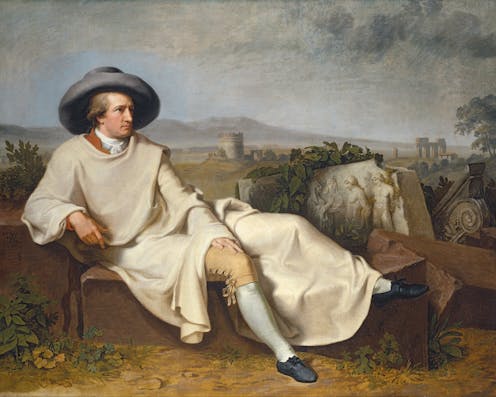
In our Guide to the Classics series, experts explain key works of literature.
This month marks the 250th anniversary of the publication of Johann Wolfgang von Goethe’s celebrated and controversial novel Die Leiden des Jungen Werther. Commonly known in English as The Sorrows of Young Werther, it has endured in the popular imagination.
Goethe wrote the semi-autobiographical novel as a young, idealistic man, spurred by his infatuation with the engaged Charlotte Buff. Later in life, cutting a more sober figure, Goethe would look back uneasily on the frenzied product of his youth and “the pathological condition from which it sprang”.
Werther, he said, haunted him from the imaginary grave like a vengeful ghost.
Storm and stress
In essence, The Sorrows of Young Werther is a maudlin tale of unrequited love. It is an epistolary novel, presented as a collection of letters written by Werther to his friend Wilhelm. The letters reveal Werther’s sensitive and artistic soul, as well as his passionate temperament.
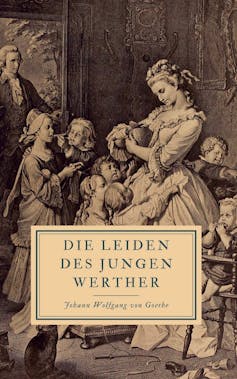
Werther meets and falls in love with Charlotte (or Lotte), a beautiful young woman who has been left in charge of her younger siblings after their parents‘ death. Charlotte is already engaged to a respectable and amiable older man, Albert. Caught in her orbit in the idyllic village of Wahlheim, Werther writes letters that are part romantic rhapsodies on the restorative beauty of nature and the simplicity of rural life, and part jaded tirades on the artificiality of polite society and courtly politics.
As the novel progresses, Werther’s weltschmertz – his world-weariness – takes hold, as does the torture of unfulfilled love. One night, in Albert’s absence, Werther is unable to contain his passion. He confesses his love to Charlotte, only to be rebuked for his wilfully self-destructive delusions.
Werther’s letters come to an end; it is left to the cold, officious voice of the “Editor” to put together the pieces of his last hours. The flash of gunpowder and the sound of gunshot at midnight fails to arouse alarm. Werther is found the next morning on the bloodied floor of his study. The following night he is buried in his favourite spot, with neither Charlotte nor Albert, nor any clergymen, in attendance.
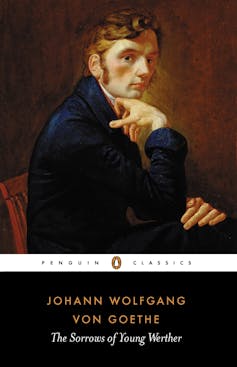
Goethe’s novel is very much a product of its times. It is a key example of the German proto-Romantic movement known as Sturm und Drang – or “storm and stress” – which valourised individualism, inspiration and passion over the rational tenets of classicism and the Enlightenment. It is also a turning point in the history of the cult of “sensibility”, an 18th-century term used to describe a refined capacity to feel.
The Sorrows of Young Werther certainly tugged at the heartstrings of its readers. As a novel of letters, it seemingly offered unfettered access to Werther’s spontaneous effusions of the heart. It also sentimentalised his suicide, an act still frequently condemned in the late 18th century as sinful, criminal and cowardly.
With Werther’s death, sensibility transformed from a laudable virtue to a pathological hypersensitivity to the world, or in Charlotte’s words a “too warm sympathy with everything”. For this reason, Goethe’s man of feeling attracted as much scorn as he did sympathy.
Werthermania!
The Sorrows of Young Werther became a worldwide bestseller. It was translated into French in 1775 and English in 1779 – where it gained especial notoriety. It soon travelled across the Atlantic to America.
The novel attracted an enormous variety of responses. Novelists, playwrights, poets, illustrators and composers were drawn to reimagine Werther’s fate. In English alone, Werther would be invoked as a cultural reference point in many a Romantic novel, including those of Charlotte Smith, Jane Austen’s Sense and Sensibility, and Mary Shelley’s Frankenstein.
William Godwin’s poorly judged memoir of his late wife and Mary Shelley’s mother, Mary Wollstonecraft, led to her being described as a “female Werther” for her suicide attempts.
Even Napoleon was a fan. When the French emperor met Goethe in Erfut in 1808, he confessed he had read the novel seven times.

More immediately, though, Werthermania would gain its hold on the popular imagination through material and visual culture. Young men of fashion would parade in Werther’s trademark yellow waistcoat, blue jacket and high boots – the very outfit worn by Goethe’s friend Karl Wilhelm Jerusalem, whose 1772 suicide served as a model for Werther’s. This ensemble became visual shorthand for suicidal sensibilities, whether for sentimental or politically satirical purposes.
Images of Werther and Charlotte were reproduced on fashion accessories, including fans, gloves, jewellery and expensive porcelain and china mementos. Women could wear the perfume “Eau de Werther” (although one is puzzled by what that fragrance might have been).
Cheap sentimental prints depicting various scenes from the novel also circulated widely across Europe. Most popular were illustrations of a young and beautiful Charlotte mourning at Werther’s grave – a pathetic scene that never occurs in the novel.
Such images remind us of how the novel took on a life of its own, beyond the bounds of its fictional narrative. Other images, conversely, went to great lengths to satirically undercut such pathos by exposing the grubby commercialism of this mawkish sentimentalism.
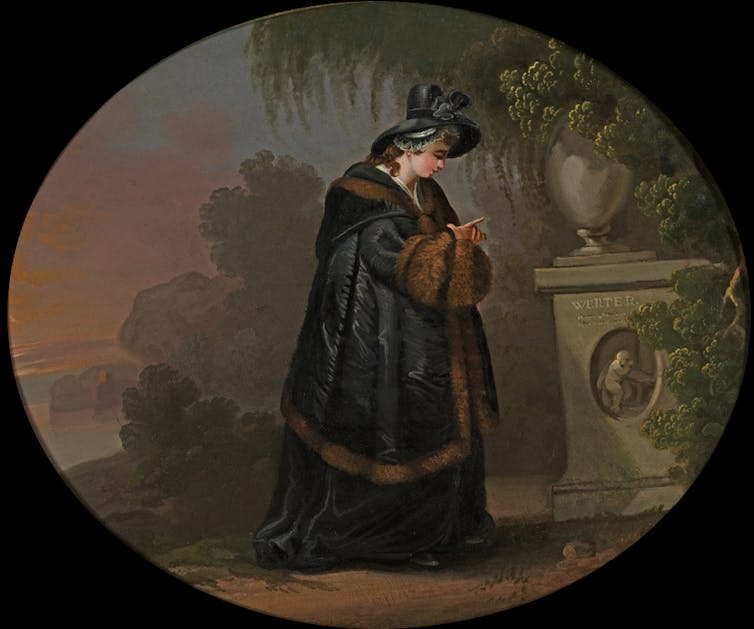
The playful slippage between fiction and reality fuelled the novel’s vibrant popular reception. The same capacity would give rise to concerns over its potentially harmful influence.
Goethe feared the novel’s possible effect on impressionable readers from the outset. In recognition of this, he added a final italicised line to the novel’s second 1775 edition: “Be a man, and do not follow me.” The novel was substantially reworked by Goethe in 1787, as further implicit acknowledgement of its potentially deleterious impact on forlorn lovers.
As Charles Moore lamented in his attack on fictional portrayals of suicide in Full Inquiry in the Subject of Suicide (1790), Werther was often read “not as a fictitious, but a real character”. A true story, he observed, “more engages the attention and increases the mischief”.
Mischief indeed! Popular opinion would have it that Europe was in the grip of Werthermania, with copycats emulating his suicide across Britain and the continent. The truth is likely to be less dramatic, but newspapers from several countries did report people committing suicide wearing Werther’s trademark outfit with a copy of Goethe’s novel nearby.
Some authorities responded decisively: both the novel and Werther’s style of dress were banned in Leipzig – where the novel was first published – as early as 1775. The novel was also banned in Denmark and Italy in an effort to stop the spread of suicidal contagion. This perceived mania caused novelist Madame De Staël to quip, many years later in 1813, that Werther had “caused more suicides than the most beautiful woman in the world”.
The novel’s infamous reputation had been secured.
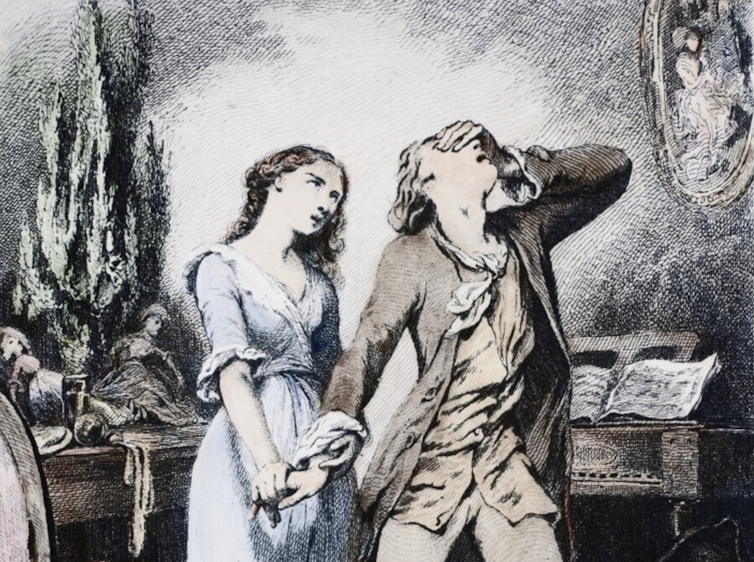
The Werther effect
By the late 20th century, the novel’s reputation for prompting copycat suicides had solidified into a sociological paradigm.
In 1974 – 200 years after the novel’s publication – US sociologist David P. Phillips coined the term “Werther effect” to describe the negative influence of media portrayal of suicides, having observed increased numbers of suicides in response to reporting in the New York Times.
In subsequent decades, the Werther effect has prompted bodies such as the World Health Organization and Mindframe to craft carefully considered guidelines on how to report and discuss suicide in the press to minimise harmful effects (guidelines by which this piece abides).
Despite these concerns, Goethe’s Werther lives on in the creative and popular imagination. Cinephiles will recognise Werther in Tom Hansen, the romantic lead in Marc Webb’s 500 Days of Summer (2009), whose melancholy is fed by the music of The Smiths rather than the poems of Ossian. More recently, Young Werther – a Canadian romantic comedy written and directed by José Lourenço – premiered at the Toronto International Film Festival to promising reviews.
And is it any wonder? For all the ink spilled debating the merits of Werther’s death, his story is equally a meditation on the joyous and painful yearnings that young love brings. In Goethe’s novel, what we have is a delightfully harrowing, timeless rendition of an eternal theme.
If this article has raised issues for you, or if you’re concerned about someone you know, call Lifeline on 13 11 14.
Eric Parisot does not work for, consult, own shares in or receive funding from any company or organisation that would benefit from this article, and has disclosed no relevant affiliations beyond their academic appointment.
This article was originally published on The Conversation. Read the original article.







